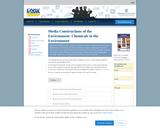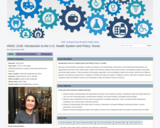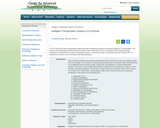
- Subject:
- Biology
- Material Type:
- Unit of Study
- Provider:
- Rice University
- Provider Set:
- OpenStax College





Survey of speech, language, and communication disorders for educators. Consideration of varied disorders that might be encountered in educational settings; application to children from culturally and linguistically diverse backgrounds.
This course is an overview of speech, language, and hearing disorders. It will investigate the impact of communication on children with developmental disabilities and enable non-specialists to work effectively with this population. Throughout this course, we will consider a range of problems (i.e. neurological and physiological disabilities), as well as applications to children from culturally and linguistically diverse backgrounds.

This is a research project which gives students a choice of modalities and platforms and encourages them to share their research with either the class or a wider public audience based on their interests, comfort with technology, openness, and preferences. Their focus can be: (1) answering a clearly defined research question related to the course topic, or (2) curating and writing material for a new or redesigned weekly unit plan for the course, including a detailed rationale for the unit. If students license a unit (re)design for reuse, it may make its way into a future version of the course. Image: "Typewriter Letters" by Laineys Repertoire, used under CC-BY-2.0.

COERLL produces online language learning materials (for example language courses, reference grammars, assessment tools, and corpora) for teachers to adopt, adapt, modify, and share, and also provides professional development tools for teachers. You can browse materials on the COERLL website.

This kit is a historical overview of American representations of chemicals from the three sisters to the Love Canal. It compares conflicting constructions about nuclear reactor safety, depleted uranium, Rachel Carson and DDT. Through analyzing diverse historic and contemporary media messages, students understand changing public knowledge, impressions and attitudes about chemicals in the environment.

A first lecture in Early Jazz, covering Freddie Keppard, King Oliver, Jelly Roll Morton and basic style characteristics. Designed by Professor Jon De Lucia for the Intro to Jazz Course at the City College of New York.

“Ekphrasis: An Exploration of Poetry Inspired by Art” is a multidisciplinary Open Educational Resource that showcases ekphrastic poems in the public domain alongside the artworks that inspired them. Collections of resources about each poem and the associated artwork both complement and supplement the poems. Resources include biographical information about the poet, and the artist where applicable, as well as articles, videos, audio files, presentations, and podcasts illuminating the historical significance of each work of literature and piece of art.

Overview and examination of problems in health care delivery in the United States. Introduction to the fundamental characteristics and organizational structures of the. health system. Study of the historical, political, ethical, and economic, and regulatory aspects of the public and private health systems. Critical evaluation of the quality, organization, and accessibility of health care services, and the role of different agencies and branches of government. Comparison of health care policy and systems in different countries.

This ITS ePrimer provides transportation professionals with fundamental concepts and practices related to ITS technologies. This resource can help practicing professionals and students better understand how ITS is integrated into the planning, design, deployment, and operations of surface transportation systems. The ePrimer is both a stand-alone reference document for the practitioner as well as a text for education and training programs.

Progress of every profession, academic discipline and society at large rides on the back of research and development. Research generates new information and knowledge. It is a standardized process of identifying problem, collecting data or evidence, tabulating data and its analysis, drawing inference and establishing new facts in the form of information. Information has its life cycle: conception, generation, communication, evaluation and validation, use, impact and lastly a fuel for new ideas. Research results are published in journals, conference proceedings, monographs, dissertations, reports, and now the web provides many a new forum for its communication. Since their origin in the 17th century, the journals have remained very popular and important channels for dissemination of new ideas and research. Journals have become inseparable organ of scholarship and research communication, and are a huge and wide industry. Their proliferation (with high mortality rate), high cost of production, cumbersome distribution, waiting time for authors to get published, and then more time in getting listed in indexing services, increasing subscription rates, and lastly archiving of back volumes have led to a serious problem known as "Serials Crisis". The ICT, especially the internet and the WWW, descended from the cyber space to solve all these problems over night in the new avatar of e-journals. Their inherent features and versatility have made them immensely popular. Then in the beginning of the 21st century emerged the Open Access (OA) movement with the Budapest Open Access Initiative (BOAI). Philosophy of open access is to provide free of charge and unhindered access to research and its publications without copyright restrictions. The movement got support from great scientists, educationists, publishers, research institutions, professional associations and library organizations. The other OA declarations at Berlin and Bethesda put it on strong footings. Its philosophy is: research funded by tax payers should be available free of charge to tax payers. Research being a public good should be available to all irrespective of their paying capacity. The OA has many forms of access and usage varying from total freedom from paying any charges, full permission to copy, download, print, distribute, archive, translate and even change format to its usage with varying restrictions.
In the beginning, OA publications were doubted for their authenticity and quality: established authors and researchers shied away both from contributing to and citing from OA literature. But Committee on Publication Ethics (COPE, 1997) and its code of conduct formulated in collaboration with DOAJ and OASPA, etc. have stemmed the rot. They have defined best practices and compiled principles of transparency for quality control to sift the grain from the chaff; to keep the fraudulent at bay. Now it is accepted that contributors to OA get increased visibility, global presence, increased accessibility, increased collaboration, increased impact both in citations and applications, and lastly instant feedback, comments and critical reflections. This movement has got roots due to its systematic advocacy campaign. Since 2008 every year 21-27 October is celebrated as the OA week throughout the world. There are many organizations which advocate OA through social media and provide guidance for others.
Open Access research literature has not only made new ideas easy and quick to disseminate, but the impact of research can be quantitatively gauged by various bibliometric, scientometric and webometric methods such as h-index, i-10 index, etc. to measure the scientific productivity, its flow, speed and lastly its concrete influence on individuals, and on the progress of a discipline. The OA movement is gaining momentum every day, thanks to technology, organizational efforts for quality control and its measureable impact on productivity and further research. It needs to be strengthened with participation of every researcher, scientist, educationist and librarian. This module covers five units, covering these issues. At the end of this module, you are expected to be able to:
- Define scholarly communication and open access, and promote and differentiate between the various forms of Open Access;
- Explain issues related to rights management, incl. copyright, copy-left, authors’ rights and related intellectual property rights;
- Demonstrate the impact of Open Access within a scholarly communication environment.
This is Module One of the UNESCO's Open Access Curriculum for Library Schools.
Full-Text is available at http://unesdoc.unesco.org/images/0023/002319/231920E.pdf.






